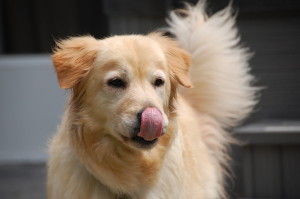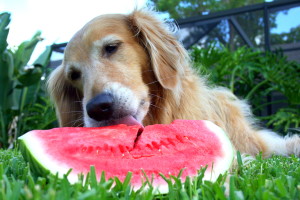Feeding Your Golden
With the wide array of foods available today, it can be hard to make a good choice of what to feed your golden. Goldens are particularly sensitive to dietary concerns, and feeding them a high quality diet can help boost their health and immune system. Feeding a high quality food is not necessarily more expensive. Price is misleading: cheaper foods require more volume to be fed, up to several cups at each meal. With the wide array of better foods available today, you can make a smart choice of what to feed your golden.
A golden will normally eat about two cups of premium food per day. It can be adjusted a little more or less based on activity level and metabolism. Goldens are prone to skin problems, and a poor quality diet will cause skin problems which translates into costly veterinarian bills. You will need to go to the pet store to purchase your food. Grocery store brands do not offer the nutrition goldens need for good health. Do not assume that just because a pet food is available from your veterinarian’s office that it is okay; read the ingredients and decide for yourself.
Do not be persuaded by fancy advertising. Many commonly hyped foods are not high quality and maybe lacking the necessary nutritional value for your dog. For example, Grain Free foods may play a major part in taurine deficiency in Golden Retrievers and other large breed dogs. This deficiency can cause serious heart problems for your dog (see Taurine and Grain Free information on this web page).
Here are some guidelines:
- Look for food free of chemical preservatives.
Do not feed foods with Ethoxyquin, BHA, BHT, propylene glycol, or sodium nitrate/nitrite. Some of these additives are suspected of causing cancer. Look for food preserved with Tocopherols (Vitamins C and E) as well as rosemary and other herbs.

- When purchasing naturally preserved foods, always check the “purchase by” date on the bag.
Make sure you have several months before this date. Frequent stores where there is a good turnover of food so you get a fresh bag. Don’t buy a bag that has grease stains on the outside and never feed moldy dog food to your dog. Always store dog food in a tight airtight container in a cool, dry place. If you only have one dog, consider buying 10-15 pound bags instead of 20-40 pounds bags so the food is fresher.
- Look for a food that has some form of meat as the first ingredient – such as lamb, chicken, or turkey.
Avoid foods that have grain as the first ingredient. Also look for multiple meat proteins in the first seven ingredients. Protein from multiple sources is generally viewed as being beneficial (such as lamb, chicken and fish), unless your dog is allergic to certain proteins. Dog food companies sometimes list several types of grains in the first seven ingredients. Beware of this – your dog needs animal protein in his diet!
- Don’t buy food that contains animal digest.
These are the intestines of the animal including what is in the intestines!! Most by-products are not desirable. By-products normally contain beaks, feet, feathers, heads and other slaughterhouse wastes – not the most nutritious part of the animal. For example, “poultry by products” can include chicken heads, feathers, feet and viscera.
- Avoid foods that have sugars or artificial colors or flavors or a lot of added salt.
Semi-moist dog foods are the worst – they usually are loaded with artificial colors and sugars. Added vitamins and minerals are beneficial only when applied after the baking process, because heat destroys vitamins. We often recommend adding a vitamin/mineral supplement to your dog’s diet, but please first check with your veterinarian.
- The best foods are made up of ingredients that would be suitable for human consumption.
Most dog foods contain meat products that are not fit for human consumption. They can include meat from diseased livestock, condemned material from slaughterhouses (such as tumors cut away from meat), and as horrible as it sounds, some pet foods include euthanized pets sold to rendering plants and even road kill. Is it any wonder why so many dogs die from cancer when they are being fed meat from these sources? Don’t hesitate to call your dog food company and ask them questions about what grade of meat goes into their dog food.
- Grains – many dog foods will contain some grains, for example, brown rice, barley, corn, wheat, etc.
We have found that some goldens in our rescue program generally do poorly on a food that contains corn or soy. These ingredients just don’t seem to be beneficial to most goldens. Many goldens are allergic to corn or wheat. So if your golden starts getting a lot of hot spots or skin problems – check his food. There is a big difference in quality of grain products. Look for whole rice or brown rice in the ingredients; white rice and ground brewers rice are much lower in nutrients than whole or brown rice. Often pet food companies take the sweepings off the mill floor and put it in pet food. These products are called “grain fractions” and include brewers rice, rice gluten, rice bran, corn gluten meal. Look for whole grains instead such as oatmeal, brown rice, barley, or whole oats.
- Grain Free foods.
Grain Free foods have become increasingly available as food companies try to offer foods that are easier to digest with lower levels of complex carbohydrates and grains. One misconception is that grain free dog food is also low-carb, however, vegetables such as potatoes, sweet potatoes, green peas and tapioca often replace the grains in grain-free dog foods, especially in kibble foods, making them as high or higher in carbohydrates than grain-based dog foods.
- Studies have shown peas, beans, pea starch, legumes, potatoes and sweet potatoes that have replaced the grains in dog foods block the function of taurine. Taurine, a sulfuric acid, is essential for healthy cardiovascular function in Golden Retrievers. If left untreated, taurine deficiency in Golden Retrievers can cause dilated cardiomyopathy (DCM), congestive heart failure and possibly death.
- Read all the ingredients in the food (which should include taurine) and check with your veterinarian before selecting or feeding any grain free food to your dog.
Detailed information on dog food ingredients and taurine can be found on this web page under Taurine and Grain Free information and at: Diet Associated Heart Disease
- Treats – beware of many dog treats out there.

They are filled with sugars, preservatives and artificial colors. Try buying biscuits at your local dog bakery or making some yourself. The dog food companies listed below have high quality treats available for your dog.
- Is your dog overweight? We recommend cutting your dog’s regular kibble back by 1/3, and adding half a can of green beans (no salt variety preferred) in each meal. Beware of some diet dog foods, they can be loaded with fillers that provide no added nutrition. At least green beans are healthy. You can also use canned pumpkin. Typically goldens love it! DO NOT free feed your golden; instead feed a measured amount of food twice a day. Most adult goldens will eat 1 cup of premium dog food twice a day. Is your dog too fat? You should be able to feel its ribs and your dog should have a waist. We have found that we have a different view of what constitutes a fat dog than many veterinarians. They will typically allow dogs to carry more weight than is optimal. This perhaps is because they do not want to insult their clients and risk losing business. Letting your golden get too fat is like chopping years off of its life. We also see lots of hip problems with goldens, and keeping weight in check will give your dog better mobility. Fat goldens are an epidemic from our experience. We routinely get goldens into our rescue program that have to lose 30 – 40 pounds!!! Therefore we have a lot of experience at taking the weight off! It is very discouraging and upsetting when an adoptive home will let some weight creep back on. You may think you are loving your dog by giving it too much to eat, but if you really love it you will keep it at a normal weight. Remember – Ribs and Waists! Can you feel and see them on your dog? If not, break open the cans of green beans!
The bottom line is read the ingredients, consult your veterinarian and research reliable resources. Making sure your dog has the best nutritional food will help to insure he has a long and healthy life.
Here, from Whole Dog Journal, are some additional links for selecting best dry dog food and the best canned dog reviews.
